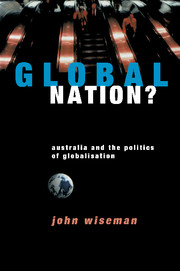Book contents
- Frontmatter
- Contents
- Abbreviations
- Acknowledgments
- 1 Introduction: Australia and the Politics of Globalisation
- 2 Breaking the Spell? Understanding Globalisation
- 3 Transforming the Global Economy? Trade, Capital and Power in the Late Twentieth Century
- 4 Onto the Global Racetrack? Globalising the Australian Economy
- 5 The Price of Competitiveness? The Social Impact of Globalisation on Australia
- 6 Wired to the World? Australia and the Globalisation of Media and Information Technologies
- 7 Nowhere to Hide? Australia in the Global Environment
- 8 Where in the World? Transforming Australian Political Relationships and National Identities
- 9 Alternative Strategies? Thinking and Acting Globally and Regionally
- 10 Alternative Directions? Thinking and Acting Locally and Nationally
- 11 Conclusion
- Notes
- Bibliography
- Index
7 - Nowhere to Hide? Australia in the Global Environment
Published online by Cambridge University Press: 20 May 2010
- Frontmatter
- Contents
- Abbreviations
- Acknowledgments
- 1 Introduction: Australia and the Politics of Globalisation
- 2 Breaking the Spell? Understanding Globalisation
- 3 Transforming the Global Economy? Trade, Capital and Power in the Late Twentieth Century
- 4 Onto the Global Racetrack? Globalising the Australian Economy
- 5 The Price of Competitiveness? The Social Impact of Globalisation on Australia
- 6 Wired to the World? Australia and the Globalisation of Media and Information Technologies
- 7 Nowhere to Hide? Australia in the Global Environment
- 8 Where in the World? Transforming Australian Political Relationships and National Identities
- 9 Alternative Strategies? Thinking and Acting Globally and Regionally
- 10 Alternative Directions? Thinking and Acting Locally and Nationally
- 11 Conclusion
- Notes
- Bibliography
- Index
Summary
Globalisation is quite clearly the biggest environmental problem. Globalisation requires that we start to export things that we've never exported before, and start to import things we've never imported before. For instance exporting our biodiversity, our livestock wealth, products of our coastal ecosystem like shrimp, flowers produced through intensive irrigation in low rainfall zones (so that we're exporting our water). Importing things like toxic wastes …
Indian environmental activist, Dr Vandanna Shiva, 1997To call [Australia's position on Greenhouse Gas emissions] irresponsible is too mild. To call it moronic would be to compliment it. Australia could be taking a major role by demonstrating large scale solar power and selling it to China and India. Instead it's behaving like a dumb European country of 1860.
Professor Paul Ehrlich, 1997On 20 October 1997 a team of Greenpeace activists scaled the walls surrounding Kirribilli House, the Sydney residence of Australian Prime Minister, John Howard. Solar panels were rushed past the security guards and lifted up on to the roof as a ‘gift’ to the Prime Minister. From the roof the protesters used mobile phones to inform the Australian and international media about their opposition to the Australian Government's refusal to support common and binding greenhouse-gas emission targets.
The Prime Minister's response was that ‘noisy groups such as Greenpeace will … have absolutely no impact at all on the direction of government policy’.
- Type
- Chapter
- Information
- Global Nation?Australia and the Politics of Globalisation, pp. 86 - 100Publisher: Cambridge University PressPrint publication year: 1998

